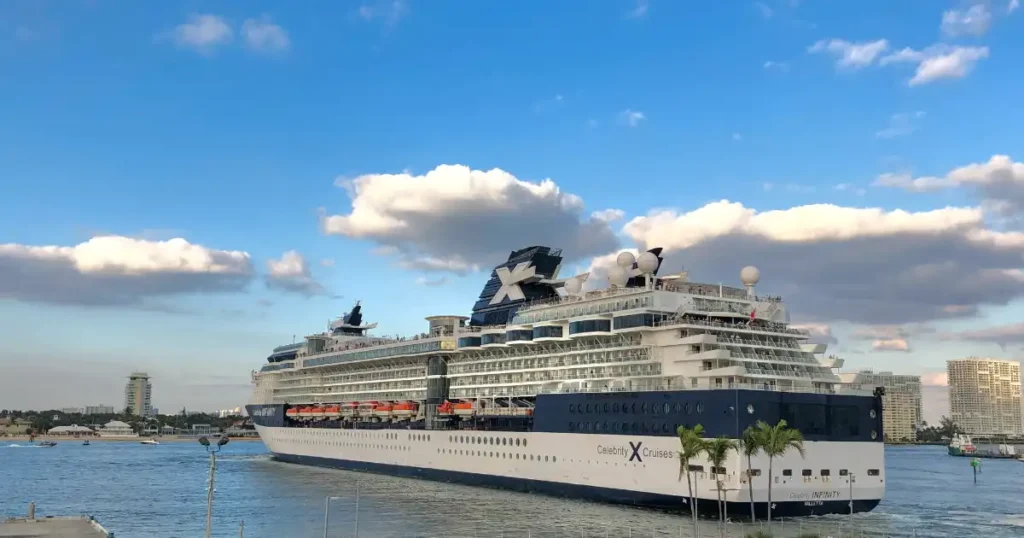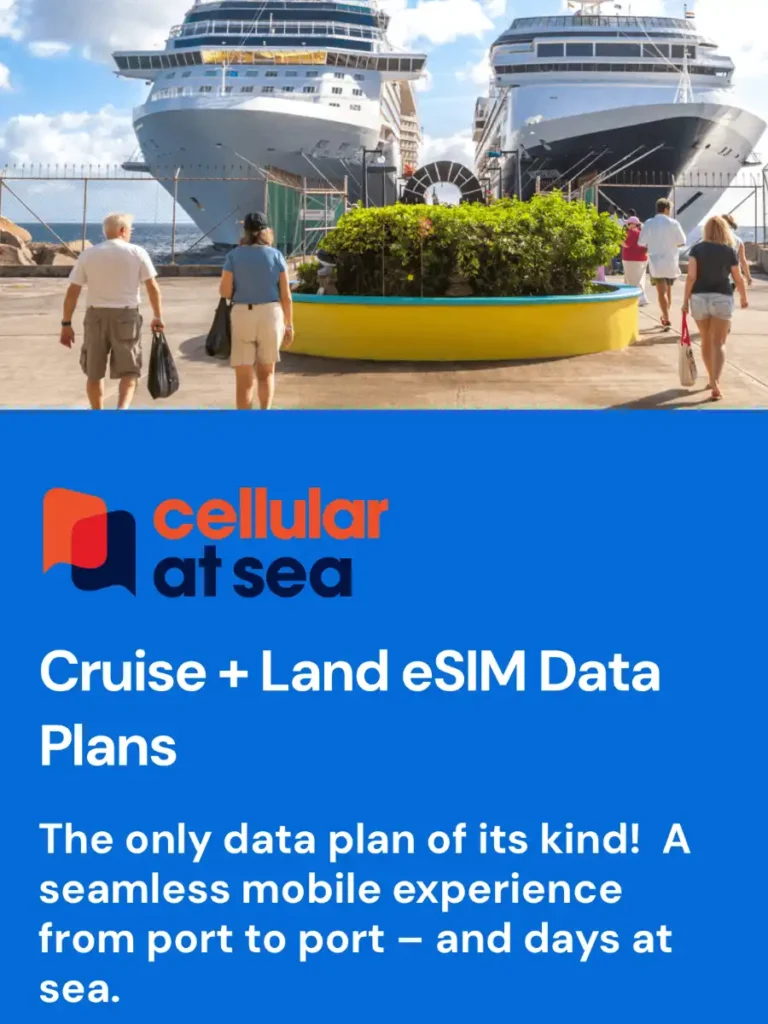Staying Connected at Sea: Exploring Wi-Fi and Cellular At Sea Options for Cruisers
For modern travelers, staying connected while cruising has become more than a convenience; it’s a necessity. Whether working remotely, keeping in touch with loved ones, or streaming your favorite shows, finding reliable and affordable options at sea can be challenging. Cruise lines often charge for premium Wi-Fi, and Cellular at Sea plans vary widely, leaving many wondering: Is staying connected worth the cost?
From cruise-specific cellular at-sea plans to ship-provided Wi-Fi and innovative eSIM solutions like GigSky, and Airalo, there are plenty of choices to explore. Each option has its own pros, cons, and price tags. In this guide, we’ll break down the best connectivity options available so you can make an informed decision and stay connected on your next cruise—without breaking the bank.
Table of Contents
QUICK NOTE: This post contains affiliate links and Two Traveling After One may receive a commission for purchases made through these links, at no extra cost to you.

Major Provider Cellular Plans: Convenient But Limited
Cruise-specific cellular plans from major providers like AT&T, Verizon, and T-Mobile allow travelers to connect through Cellular at-Sea networks, which function when ships are at least 12 nautical miles offshore. Once activated, these plans enable passengers to use their mobile devices as they would on land, although this service often incurs additional fees.

Cost of Major Provider Cellular at Sea Plans
Major provider Cellular at Sea plans have been notoriously expensive. Packages are designed for occasional lighter use and don’t include options like emails, texts, or streaming.
For perspective, using just 1 GB of data, a typical amount for basic online tasks like emails, navigation, and social media, can lead to shocking bills, mainly if you rely on your phone for work or regular communication.
The major cellular provider’s rates for cellular at-sea usage are typically tied to partnerships with cruise lines and networks like WMS (Wireless Maritime Services). Here are some examples we found:
- AT&T offers a “Cruise Plus” plan for $100, which includes unlimited talk and text plus 1GB of data. They also have a basic plan for $60, providing 100 minutes of talk, unlimited text, and 100MB of data. Without a plan, pay-per-use data is billed at $2.05/MB.
- Verizon provides a $20/month option for 50MB of data on select ships. Alternatively, their general rate for at-sea usage is $2.99 per minute for calls and $20 per 50MB of data.
- T-Mobile does not offer specific at-sea data packages, but their rates include $5.99 per minute for voice and $0.50 per text sent. Data is typically unavailable while at sea.
Check Out Our Latest Videos!
Pros and Cons of Major Cellular Providers’ At-Sea Plans
Pros:
- Familiar Service Providers: Using your existing cellular provider simplifies billing and avoids the hassle of switching to new platforms.
- Variety of Plans: Options like AT&T’s Cruise Plus plan ($100) offer a mix of unlimited talk and text with manageable data limits (1GB), catering to different connectivity needs.
- Easy Setup: Plans are with your carrier and often easy to activate before departure, requiring minimal effort to stay connected once onboard.
- Global Coverage: Major providers partner with cruise lines and maritime networks like WMS, ensuring service availability on most ships.
Cons:
- High Costs: Prices for at-sea plans are steep compared to land-based plans, with pay-per-use data rates like AT&T’s $2.05/MB and Verizon’s $20/50MB quickly adding up.
- Limited Data: Even premium plans like AT&T’s Cruise Plus (1GB of data) can feel restrictive for heavy users who rely on streaming, video calls, or large downloads.
- Expensive Voice Rates: For providers like T-Mobile, $5.99 per minute for voice calls can make quick check-ins costly.
- Unclear Data Availability: T-Mobile lacks specific at-sea data packages, leaving users without clear connectivity solutions at sea.
- You must be out at sea and not in Port. You’ll also pay your cellular provider’s applicable rates for the country you visit when in port.

Cruise Ship Wi-Fi Plans: Accessible But Can Be Expensive
Most modern cruise ships provide onboard Wi-Fi powered by satellite connections, offering travelers the convenience of staying connected while at sea. Wi-Fi packages vary significantly across cruise lines, with options ranging from daily rates to full-trip passes. These plans are often tiered to meet different needs, from basic email and text access to internet browsing. However, costs can add up quickly; most cruise lines charge per device, requiring you to purchase a plan for the entire cruise and limit streaming to the higher-priced packages. Speeds and reliability also differ, so understanding your options is critical to choosing the right plan for your voyage.
Cost of Cruise Ship Wi-Fi Plans
The costs associated with Wi-Fi at sea vary by cruise line and itinerary, typically from $35 to $50 per day per device. While some cruise lines offer discounted rates for multi-day or voyage-long plans, others maintain premium pricing for higher-speed or unlimited packages. It’s essential to factor in these costs when budgeting for your trip, especially if multiple devices or heavy internet usage is a priority.

Pros and Cons of Cruise Ship Wifi Plans
Pros:
- High-Speed Access: We have found that, in many cases, premium internet packages are fast enough to support streaming, video calls, and other data-intensive tasks. This is best early in the morning or late at night when bandwidth is more significant due to less use across passengers.
- Unlimited Data: Unlike cellular plans, Wi-Fi packages usually provide unlimited data for the duration of the package.
- Integrated Experience: Wi-Fi is often connected to cruise apps, offering access to onboard services, schedules, and more.
- Works both at sea and in port.
Cons:
- High Cost: Premium Wi-Fi on cruise ships can be expensive, potentially adding several hundred dollars for most of our long voyages.
- Variable Speeds: Speeds can slow down significantly during peak usage times, and the service may be intermittent depending on satellite strength and location.
- No coverage when you are off the ship.
Third-Party eSIM Providers: Now, There Is A Real Alternative
For travelers seeking more flexibility and savings, third-party eSIM providers like GigSky offer a compelling alternative to cruise line and traditional cellular plans from your carrier. With prepaid, data-only eSIM plans, these providers deliver predictable pricing and easy activation for seamless international and at-sea connectivity. GigSky’s Cruise + Land eSIM covers mobile data on cruise ships, in ports, and on land, often at rates far lower than those charged by cruise lines or major cellular providers. For nomads and slow travelers, these solutions can provide reliable connectivity, especially on repositioning cruises, without breaking the bank, making them an excellent option for staying connected wherever your journey takes you.
Cost of Third-Party eSIM Providers
Third-party providers like GigSky are known for their competitive and transparent pricing, especially for modest data needs. GigSky’s at-sea plans, for instance, typically cost between $35 and $50 for 1GB of data for 7 days. These flexible plans eliminate the sticker shock of post-cruise bills, offering significant savings compared to traditional cruise line or major cellular provider options. GigSky’s Cruise and Land eSIM technology supports coverage in over 200 countries and territories, making it a practical choice for travelers combining cruises with extended land adventures. When paired with other lower-cost land-based eSIM options like GigSky or Airalo, travelers can customize their connectivity for both cost-effectiveness and convenience.

Pros and Cons of Third-Party eSIM Providers
Pros:
- Cost Savings: Plans like GigSky’s Cruise + Land eSIM ($35–$50 for 1GB over 7 days) are significantly cheaper than most cruise line or cellular-at-sea options, offering substantial savings.
- Predictable Pricing: Prepaid plans eliminate the risk of unexpected roaming fees or post-cruise bill shock.
- Flexibility: Third-party providers allow travelers to use their data on cruise ships and at international ports, covering multiple aspects of a trip.
- Global Coverage: Providers like GigSky support over 200 countries and territories, making them ideal for long-term travelers and those exploring diverse destinations.
- Easy Activation: eSIM technology enables seamless setup without requiring physical SIM cards, making activation quick and hassle-free on compatible devices.
- Device Independence: These plans don’t rely on cruise line partnerships, giving travelers more control over their connectivity options.
Cons:
- Device Compatibility: eSIM plans require an eSIM-enabled device, which may not be supported by older phones or some carriers.
- Limited Data: Plans typically offer modest data limits (e.g., 1GB for 7 days), which may not suffice for heavy internet users or streaming needs.
- Requires Planning: Travelers must research and activate plans in advance to ensure compatibility and proper coverage during their cruise.
- Separate Systems to Manage: Using a third-party provider alongside onboard Wi-Fi or cellular plans can require juggling multiple connectivity sources.
- No Voice or Text: These data-only plans do not include traditional voice calls or SMS texting, potentially limiting communication options unless paired with wifi calling, iMessage or apps like WhatsApp or Skype.
- Variable Signal Quality: As with all satellite-based services, connectivity may be affected by the ship’s location and surrounding weather conditions.
For travelers with modest data needs and compatible devices, third-party cellular providers like GigSky are an excellent way to stay connected affordably at sea and beyond. However, a combination of options may be necessary for those requiring extensive data or voice services to cover all needs.

FREE (For Now) Emergency Connectivity: A Lifeline for Loved Ones in Need
Like many of you, we have aging parents, family, or friends in need and want to make sure we can connect with them when needed. Apple’s newer iPhone satellite emergency connectivity, available on iPhone 14 and later models, allows us to send messages to emergency services when cellular and Wi-Fi coverage is unavailable. This feature is particularly useful in remote locations, such as at sea, but it has limitations that travelers should consider.
How It Works
- Connection to Satellites: The iPhone connects to satellites through the Globalstar network by pointing toward the sky. Clear visibility is required, as obstructions like dense foliage or tall structures can block the signal.
- Emergency Messages: The service connects you to responders via text in emergencies. If the local emergency services only support voice calls, Apple’s relay centers forward your text information to them.
- Activation: Satellite emergency services are included FREE for two years with the purchase of a compatible iPhone. After two years, Apple has yet to disclose pricing for continued service.
Pros and Cons of iPhone Satellite Emergency Connectivity
Pros:
- Free for Two Years: Emergency satellite messaging is included for free with iPhone 14 and newer models for the first two years, providing excellent value for essential peace of mind.
- Emergency Lifeline: This feature allows users to connect with emergency responders via text when cellular and Wi-Fi coverage is unavailable. It is invaluable in remote locations like at sea.
- Globalstar Network Coverage: The service works in many areas supported by the Globalstar satellite network, offering widespread emergency coverage.
- Accessible Setup: Activation is simple and included with compatible devices, requiring no additional hardware.
- Useful for Remote Locations: This is particularly beneficial in places with limited or no traditional connectivity, such as during voyages or in remote hiking areas.
Cons:
- Limited Coverage in Polar Regions: The service may not function well in polar regions or extreme latitudes, limiting its usefulness in cruises to destinations like Antarctica or the Arctic.
- Requires Clear Sky Visibility: A clear sky view is essential for the satellite connection, and dense foliage, ship structures, or poor weather conditions can block signals.
- Emergency Use Only: The service is designed strictly for emergencies and essential text communication; it does not support browsing, streaming, or regular connectivity needs.
- Uncertain Long-Term Costs: Apple has not disclosed the pricing for continued satellite emergency service after the initial two years, leaving future costs unknown.
- Reliance on iPhone Models: This feature is only available on iPhone 14 and newer models, which may not suit travelers with older devices or those who use non-Apple phones.
- Performance Limitations: Signal reliability can vary, and interference from ship structures or weather conditions may reduce the effectiveness of the connection during emergencies.
iPhone satellite emergency connectivity is a valuable tool for peace of mind, especially for those with loved ones or emergencies to consider while traveling. However, its limitations make it best suited as a backup solution rather than a primary method of staying connected at sea.

Which Connectivity Option is Best for You?
The best choice for staying connected at sea depends on your needs, habits, and budget. For many travelers, a combination of options provides the best balance of cost and reliability.
If you plan to use a significant amount of data onboard—for work, streaming, or consistent browsing—a ship’s premium Wi-Fi package combined with an Airalo or GigSky day plan for port days can be an intelligent approach. This way, you ensure high-speed access onboard while leveraging more affordable data in port.
For lighter data needs, a GigSky Cruise + Land eSIM plan is a great option. It offers connectivity on both ship and shore at a fraction of the cost of ship Wi-Fi plans. However, these plans come with data limits, so they’re best suited for travelers who primarily need basic browsing or occasional check-ins.
Alternatively, you can rely solely on free Wi-Fi at restaurants or cafes onshore. Whatever you choose, planning and understanding your data usage habits are essential to avoid overspending.







